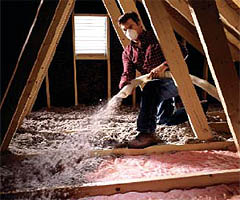 Proper insulation reduces heat loss
Proper insulation reduces heat loss
Related Links
Forced Air
Framing
Energy Star Designs
Insulation Procedures
ENERGY STAR INSULATION INSTALLATION PROCEDURES
WALL INSULATION
- Unfaced and faced batt insulation shall be: Correctly sized to fit snugly
at the sides and ends.
- Installed to completely fill the cavity.
- Cut to fit properly - there should be no gaps nor should the insulation be
doubled-over or compressed.
- Non-standard width cavities shall be filled by batt insulation cut
approximately one inch (1") wider than the space to be filled.
- Butt fit cut around wiring and plumbing, or be split (delaminated) so that
one layer will fit behind the wiring or plumbing and the other layers fits
over it.
- If faced, facing should be placed toward heated spaces and touch drywall.
- Faced insulation must be properly stapled over the face of the studs; it
must be continuous and have no penetrations.
- Unfaced insulation shall be covered with 6mil poly and evenly overlapped
at ceiling and floor. All seams and tears shall be taped.
- Each faced batt should be stapled approximately every eight (8) inches, or
according to manufacturers specifications on facing.
- All tears or breaks in the facing six (6) inches or longer shall be sealed
with waterproof tape. Tears and breaks in the facing should be minimal.
NARROW-FRAMED CAVITIES AND "CHINKING"
- Narrow spaces (2" or less) at windows, between studs at the building's
corners, and at the intersections of partitions and walls shall be filled with
small pieces of insulation: care should be taken not to compress the
insulation.
- Insulation shall be cut to fit around wiring and plumbing without
compression.
- Insulation shall be placed between the sheathing and the rear of
electrical boxes.
- Insulation shall be cut to fit around junction boxes.
- Water pipes shall have at least two thirds of the insulation between the
water pipe and the outside, as much insulation as possible shall be placed
behind the pipe and no insulation shall be placed between the pipe and the
heated area.
RIM JOISTS
- All rim joists shall be insulated to the same R-value as the walls.
- As necessary, insulation shall be cut to fit snugly into the rim joist
cavity.
- An alternative to fitting insulation in a web truss located at the rim
joist is to completely cove the truss with insulation, snug to the upper and
lower floors.
BATT CEILING INSULATION
- Follow same procedures as WALL INSULATION plus these.
- For batts that are taller than the trusses, full-width batts should be
used so that they expand to touch each other over the trusses.
- Insulation shall be cut to fit around and shall cover all IC rated
recessed lighting fixtures.
SPECIAL SITUATIONS
- Insulation at bridging (cross bracing) shall be split lengthwise at the
center and placed half into the lower opening and half into the upper opening
of bridging (cross bracing) of ceiling and/or floor joists.
- Alternatively, insulation is butted to the bridging and the space is
filled with scrap insulation.
- Attic access panels shall have rigid foam board or batt insulation that is
equal to or greater than the R-value of the insulation on the attic floor.
This insulation shall be permanently attached using adhesive or mechanical
fasteners.
RAISED FLOORS AND FLOORS OVER GARAGES
- Follow procedures in WALL INSULATION and CEILING INSULATION plus these.
- Batts should be no more that 1" wider than the cavity so as to eliminate
buckling.
- If faced, the facing should be placed toward heated area.
AIR SEALING PROCEDURES
- Prior to the installation of any insulation, the building shell must be
air sealed with caulking and or foam sealant. Seal all voids in the exterior
wall sheathing.
- Seal all areas where you can see daylight such as; bottom wall plate to
floor, top wall plate to rim joist, all electrical, plumbing and heating
protrusions to the exterior or other floor levels.
- Seal access to any cavity that opens to the conditioned space. For
example, if you have a wall cavity with an electrical outlet, the wiring that
exits that cavity goes through a hole that connects either the two cavities or
the cavity and another floor, basement, or attic area. This helps reduce air
flow from unconditioned spaces through the outlet to conditioned spaces.
- Seal all windows and doors between the rough opening stud and the window
frame. Remember, fiberglass insulation only filters air, it does not act as a
sealant.
|